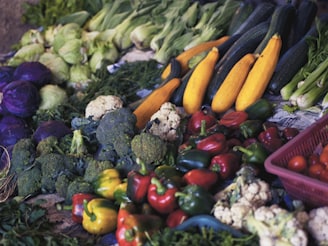
What Do You Know About Eating Vegetables?
Eating more vegetables is always part of healthy eating and constantly associated with positive health outcomes such as in gut health (1) , weight (2), cholesterol (3), blood pressure(4) , diabetes (3), and chronic kidney disease (5) management.
Some people I met like to eat vegetables, which is great but there are others that find eating vegetables challenging. There are also some people that have no problem eating lots of vegetables however only restricted to a few types of vegetables. In fact, less than 1 in 10 Australians (7.5%) met the dietary guideline for daily vegetable intake in 2017-18. (6)
Australian Dietary Guidelines recommends 5 serves vegetables a day and encourages a variety of colourful vegetables consumption. In fact, one of the largest international gut microbiota studies (7) showed that individuals that consume more than 30 different plants a week had the most diverse microorganisms in our gut and associated with most beneficial gut health. In turn, good gut health provides beneficial outcomes to chronic diseases such as chronic kidney disease (8), obesity, high blood pressure, high cholesterol, and diabetes. (9)
A serve of vegetable is equivalent to 1 cup leafy salad or 1/2 cup cooked vegetables or non-leafy vegetables. Before I dealt into details of how to meet vegetable intake recommendation, I would first like to introduce two groups of vegetables- starchy and non-starchy vegetables. In most cases, most people find it challenging to consume enough non-starchy vegetables. What exactly is non-starchy vegetables? What about starchy vegetables? Would eating 5 serves starchy vegetables a day good enough?
Starchy vegetables are great source for fibre, vitamins, minerals, and antioxidants. In addition, they also contain good amount of carbohydrate which will be broken down to glucose and raise blood glucose level. Because of the carbohydrate content, starchy vegetables are higher in calories than non-starchy vegetables. Therefore, keep your starchy vegetable consumption to 1/4 plate or 1/2 cup per meal/ setting is recommended. For people with diabetes, they should match their starchy vegetable consumption to blood glucose level. For more information on proper way to consume starchy vegetables according to blood glucose level, consult an Accredited Practicing Dietitian.
According to Queensland Health, a starchy vegetable includes:
a) Potato
b) Sweet potato
c) Corn
d) Legumes such as chickpea, baked beans, red kidney beans and so on
e) Taro
f) Cassava
Non-starchy vegetables, as the name suggests, contain very little carbohydrates. Examples of non-starchy vegetables include:
a) Spinach
b) Kale
c) Leafy salads such as rocket, arugula, baby spinach, and so on
d) Carrot
e) Zucchini
f) Lettuce
g) Broccoli
h) Cauliflower
i) Mushroom
j) Tomato
k) Celery
l) Leek
m) Eggplant
n) Capsicum
o) Green bean
p) Cucumber
q) Asian vegetables such as bok choy, bak choy, water spinach, choy sum
r) Brussel sprouts
s) Bean sprout
t) Fennel
u) Green bean
v) Cabbage
w) Onion and garlic
x) Spring onion
y)ginger
z) asparagus
... and the lists go on...
How much can you have for non-starchy vegetables? As they contain very little carbohydrate and hence less calories, you can load up 1/2 or more of your plate with non-starchy vegetables for the benefit of fibre, vitamin, minerals, and antioxidants.




REFERENCES
1. Klinder A, Shen Q, Heppel S, Lovegrove JA, Rowland I, Tuohy KM. Impact of increasing fruit and vegetables and flavonoid intake on the human gut microbiota. Food Funct. 2016 Apr;7(4):1788-96. doi: 10.1039/c5fo01096a. PMID: 26757793.
2. Paixão C, Dias CM, Jorge R, Carraça EV, Yannakoulia M, de Zwaan M, Soini S, Hill JO, Teixeira PJ, Santos I. Successful weight loss maintenance: A systematic review of weight control registries. Obes Rev. 2020 May;21(5):e13003. doi: 10.1111/obr.13003. Epub 2020 Feb 12. PMID: 32048787.
3. Hartley L, Igbinedion E, Holmes J, Flowers N, Thorogood M, Clarke A, Stranges S, Hooper L, Rees K. Increased consumption of fruit and vegetables for the primary prevention of cardiovascular diseases. Cochrane Database Syst Rev. 2013 Jun 4;2013(6):CD009874. doi: 10.1002/14651858.CD009874.pub2. PMID: 23736950; PMCID: PMC6464871.
4. Samadian F, Dalili N, Jamalian A. Lifestyle Modifications to Prevent and Control Hypertension. Iran J Kidney Dis. 2016 Sep;10(5):237-263. PMID: 27721223.
5. Carrero JJ, González-Ortiz A, Avesani CM, Bakker SJL, Bellizzi V, Chauveau P, Clase CM, Cupisti A, Espinosa-Cuevas A, Molina P, Moreau K, Piccoli GB, Post A, Sezer S, Fouque D. Plant-based diets to manage the risks and complications of chronic kidney disease. Nat Rev Nephrol. 2020 Sep;16(9):525-542. doi: 10.1038/s41581-020-0297-2. Epub 2020 Jun 11. PMID: 32528189.
6. https://ncci.canceraustralia.gov.au/prevention/diet/vegetable-consumption
7. McDonald D, Hyde E, Debelius JW, Morton JT, Gonzalez A, Ackermann G, Aksenov AA, Behsaz B, Brennan C, Chen Y, DeRight Goldasich L, Dorrestein PC, Dunn RR, Fahimipour AK, Gaffney J, Gilbert JA, Gogul G, Green JL, Hugenholtz P, Humphrey G, Huttenhower C, Jackson MA, Janssen S, Jeste DV, Jiang L, Kelley ST, Knights D, Kosciolek T, Ladau J, Leach J, Marotz C, Meleshko D, Melnik AV, Metcalf JL, Mohimani H, Montassier E, Navas-Molina J, Nguyen TT, Peddada S, Pevzner P, Pollard KS, Rahnavard G, Robbins-Pianka A, Sangwan N, Shorenstein J, Smarr L, Song SJ, Spector T, Swafford AD, Thackray VG, Thompson LR, Tripathi A, Vázquez-Baeza Y, Vrbanac A, Wischmeyer P, Wolfe E, Zhu Q; American Gut Consortium, Knight R. American Gut: an Open Platform for Citizen Science Microbiome Research. mSystems. 2018 May 15;3(3):e00031-18. doi: 10.1128/mSystems.00031-18. PMID: 29795809; PMCID: PMC5954204.
8. Evenepoel P, Poesen R, Meijers B. The gut-kidney axis. Pediatr Nephrol. 2017 Nov;32(11):2005-2014. doi: 10.1007/s00467-016-3527-x. Epub 2016 Nov 15. PMID: 27848096.
9. Tang WH, Kitai T, Hazen SL. Gut Microbiota in Cardiovascular Health and Disease. Circ Res. 2017 Mar 31;120(7):1183-1196. doi: 10.1161/CIRCRESAHA.117.309715. PMID: 28360349; PMCID: PMC5390330.
